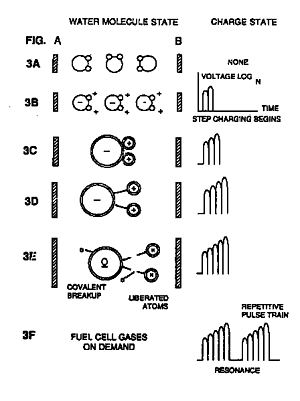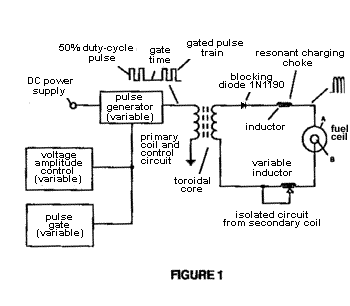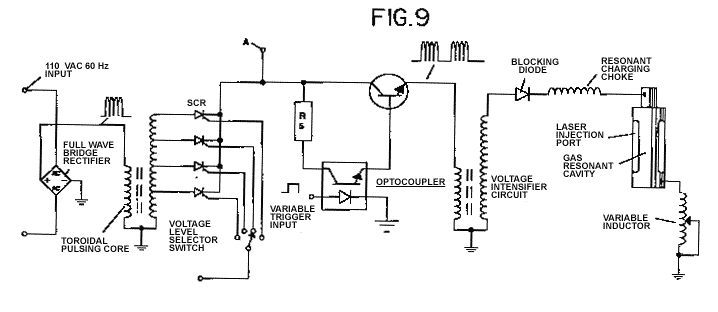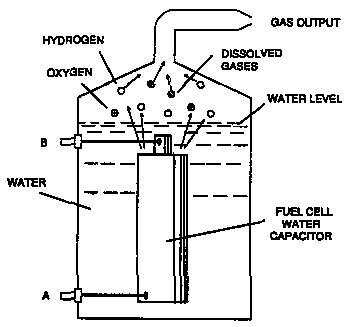Electrolysis of water is the technology of the future
Attention ! All paid and free information on this site is provided solely for educational purposes.
The author of the site does not bear any responsibility for any possible consequences of using bottom information.
Electrolysis or water instead of gasoline.
---- Obviously, the inventor from the US, Stanley Mayer, developed an electrical cell that allows ordinary tap water to be divided into hydrogen and oxygen with much less energy than required by conventional electrolysis.
---- What does this mean for you ??? How will this affect YOUR life ??? Let me tell you why it is VERY IMPORTANT TO YOU! It's just the most important thing THAT YOU READ EVER!
---- Think of BILLION US dollars, which are spent on pumping substances from the soil. We send this money to another country! (And they are fighting and killing each other and want more).
---- If this invention is installed in YOUR EXISTING CAR, you will no longer spend a cent on GASOLINE!
---- This would mean that these BILLION dollars would have stayed here in the good old America and would have been used for medical research, new technologies, space exploration and much more.
---- THIS WOULD MAKE YOUR LIFE MUCH BETTER!
---- In addition, it will help to avoid a heap of dirt. You could power the 2 most powerful devices in your home (your Air Conditioner and Refrigerator) thanks to the system using this device ... Applications are not numbered !!!!
---- THIS IS SO IMPORTANT! I CAN NOT EVEN SAY, HOWEVER!
---- STOP WHAT YOU WOULD DO AND GET THIS INFORMATION AND OTHER DATA, GIVE UP TO THE TOMER WHO KNOWS WHAT TO DO WITH THEM! TAKE OUT THE OUTPUT, DO NOT INCLUDE TV DURING DAYS!
---- DISTRIBUTE THIS, PRINT THIS AND SEND TO THE STATION RADIO, TRANSMIT BY FAX, DOWNLOAD IT ON ALL BBS WHICH FIND!
---- Know that OIL companies (greedy!) Will fight like DOGS to keep us from using this technology! DO NOT LET IT HAPPEN! MAKE THIS DUE TO GLOBALITY! DO NOT WAIT THAT SOMEONE SHALL MAKE IT FOR YOU!
---- You can see this article completely and with a color illustration of the device by visiting your local library and ordering a magazine.
Reprinted with the abbreviations from the article in "WORLD OF ELECTRONICS - WIRELESS WORLD", January 1991:
---- "It's obvious that Stanley Mayer, an inventor from the US, has developed an electrical cell that allows ordinary tap water to be divided into hydrogen and oxygen with much less energy than required by conventional electrolysis.
---- Demonstrations were conducted before by Professor Michael Laughton, Dean of Engineering at Queen Mary's College, London, Admiral Sir Anthony Griffin, former commander of the British Navy, and Dr. Keith Hindley, an English research chemist. The Mayer cell made at home by the inventor in Grove City, Ohio, produced much more hydrogen-oxygen mixture than could be expected with simple electrolysis.
---- While ordinary electrolysis of water requires a current measured in amperes, the Meyer cell produces the same effect at milliamperes. Moreover, ordinary tap water requires the addition of an electrolyte, for example sulfuric acid, to increase conductivity, the Meyer cell operates at a tremendous productivity with clean water.
---- According to eyewitnesses, the most striking aspect of Mayer's cell was that it remained cold even after hours of gas production.
---- Meyer's experiments, which he considered possible to submit to patenting, deserved a series of US patents submitted under Section 101. The presentation of a patent under this section depends on the successful demonstration of the invention to the Patent Review Committee.
---- Mayer's cell has much in common with an electrolytic cell, except that it works at high potential and low current better than other methods. The design is simple. Electrodes - send the interested to Mayer - made of parallel stainless steel plates, forming either a flat or concentric construction. The gas yield depends inversely to the distance between them. The 1.5 mm distance suggested by the patent gives a good result.
---- Significant differences are in the nutrition of the cell. Mayer uses an external inductance that forms an oscillatory circuit with a cell capacity - pure water, apparently, has a dielectric constant of about 5, to create a parallel resonant circuit. It is excited by a powerful pulse generator, which together with the cell capacitance and the rectifying diode makes up the pump circuit. A high pulse frequency produces a stepwise rising potential on the cell electrodes until a point is reached where the water molecule disintegrates and a momentary current pulse arises. The current measurement circuit detects this surge and locks the source of the pulses for several cycles, allowing the water to recover.
---- Chemist-researcher Keith Hindley offers the following description of the demonstration of Meyer's cell: "After a day of presentations, the Griffin committee witnessed a number of important properties of the WFC (water fuel cell, as the inventor called it).
---- A group of eyewitnesses to independent UK scientific observers testified that the American inventor, Stanley Mayer, successfully decomposes ordinary tap water into its constituent elements through a combination of high-voltage pulses, with an average current consumption measured only by milliamperes. The fixed gas yield was sufficient to show the hydrogen-oxygen flame, which instantly melted the steel.
---- Compared with conventional high-current electrolysis, eyewitnesses noted the absence of any cell heating. Meyer refused to comment on the details that would allow scientists to reproduce and evaluate his "water cell." However, he provided a sufficiently detailed description to the US Patent Office to convince them that he can substantiate his application for an invention.
---- One demonstration cell was equipped with two parallel excitation electrodes. After filling with tap water, the electrodes generated gas at very low current levels - no more than a tenth of an ampere, and even milliamps, as Mayer states, - the gas outlet increased when the electrodes moved closer and decreased as they moved away. Potential in the pulse reached tens of thousands of volts.
---- The second cell contained 9 cells with double stainless steel tubes and produced much more gas. A series of photographs was taken showing the production of gas at a milliampeter level. When the voltage was brought to the limit, the gas came out in a very impressive amount.
---- "We noticed that the water at the top of the cell slowly began to stain from pale cream to dark brown, we are almost certain of the effect of chlorine in heavily chlorinated tap water on stainless steel tubes used for exciting & quot.
---- He demonstrated gas production at milliampere and kilovolt levels.
---- "The most remarkable observation is that the WFC and all its metal tubes remained completely cold to the touch, even after more than 20 minutes of operation. The" Cleaving molecule "mechanism develops extremely little heat compared to electrolysis, where the electrolyte heats up fast."
---- The result allows us to consider the efficient and controlled production of gas that quickly arises, and is safe in functioning. We have clearly seen how increasing and decreasing the potential is used to control the production of gas. We saw the gas flow stop and start again, respectively, when the input voltage was turned off and on again. "
---- "After hours of discussion among ourselves, we concluded that Steve Mayer came to invent a completely new method for the decomposition of water, which revealed some features of classical electrolysis, which is confirmed by the fact that his devices actually working taken from his collection Are certified by US patents on different parts of the WFC system.Since they were submitted under Section 101 by the US Patent Office, the equipment included in the patents was tested experimentally by experts of the US Patent Office, their second experts and all applications were established. "
---- "The main WFC was subjected to a three-year trial, which raised the granted patents to the level of independent, critical, scientific and engineering confirmation that the devices actually work as described."
---- The practical demonstration of Meyer's cell is substantially more convincing than pseudoscientific jargon, which is used to explain. The inventor himself spoke of the distortion and polarization of the water molecule, which leads to an independent breaking of the bond under the action of the electric field gradient, a resonance within the molecule that enhances the effect.
---- Not counting the abundant release of oxygen and hydrogen and minimal cell heating, eyewitnesses also report that the water inside the cell disappears quickly, passing into its constituent parts in the form of an aerosol from a huge number of tiny bubbles covering the cell surface.
---- Meyer said that he has a hydrogen-oxygen mixture converter for the past 4 years, using a chain of 6 cylindrical cells.
Brief description of the drawings
FIGURE 1 illustrates the scheme used in the process.
FIGURE 2 shows the "water condenser" in perspective.
FIGURES 3a through 3f illustrate the theoretical background of the phenomena observed during the operation of the invention.
---- Description of the best implementation:
---- Briefly, the invention is a method for producing a mixture of hydrogen and oxygen and other gases dissolved in water.
---- The process is as follows:
(A) a capacitor in which water is enclosed as a dielectric liquid between the plates, included in a series resonant circuit with a choke
(B) a pulsating unipolar voltage is applied to the capacitor, in which the polarity is not connected to an external grounding, due to which the water molecules in the capacitor are subject to a charge of the same polarity and the molecules are stretched by the action of electric polar forces
(C) select the frequency of the pulses arriving at the capacitor corresponding to the natural resonance frequency of the molecule
(D) the prolonged action of pulses in the resonance mode leads to the fact that the vibrational energy level of the molecules increases with each pulse
(E), the combination of a pulsating and a constant electric field leads to the fact that at some point the strength of the electrical bond in the molecule is attenuated so much that the strength of the external electric field exceeds the binding energy and that the oxygen and hydrogen atoms are released as independent gases
(F) collection of a ready-to-use mixture of oxygen, hydrogen and other gases dissolved in water as fuel.
The sequence of processes is shown in the following Table 1, in which water molecules undergo an increase in electrical forces. In the ordinary state, randomly oriented water molecules are aligned with respect to the external field.
---- Constructional parameters, based on knowledge of theoretical principles, allow calculating the energy of the constant and pulsed current necessary for the decomposition of water.
---- TABLE 1
-------------------------------------------------- -----------------
Sequence of states of a water molecule
And / or hydrogen / oxygen / other atoms:
-------------------------------------------------- -----------------
A. random
B. orientation of molecules along field lines of force
C. Polarization of the molecule
D. lengthening of the molecule
E. disruption of the covalent bond
F. Release of gases
-------------------------------------------------- -----------------

---- The optimal gas yield is achieved in a resonant circuit. The frequency is chosen equal to the resonance frequency of the molecules.
---- For the manufacture of condenser plates, preference is given to T-304 stainless steel, which does not interact with water, oxygen and hydrogen.
---- The beginning of gas output is controlled by a decrease in operating parameters. Since the resonance frequency is fixed, the performance can be controlled by changing the pulse voltage, shape or number of pulses.


---- The rising coil is wound on a conventional toroidal ferrite core of 1.50 inches in diameter and 0.25 inches in thickness. The primary coil contains 200 turns of 24 calibers, a secondary 600 turns of 36 calibers.
---- The type 1N1198 diode serves to rectify the AC voltage. Pulses of duty ratio 2 are applied to the primary winding. The transformer provides an increase in voltage by a factor of 5, although the optimum coefficient is selected in a practical way. The throttle contains 100 turns of 24 caliber, 1 in. In diameter. There must be a short break in the pulse train. Through an ideal capacitor no current flows. Considering water as an ideal condenser, we are convinced that energy will not be spent on heating water.
---- Real water has some residual conductivity, due to the presence of impurities. It is better if the water in the cell is chemically pure. Electrolyte is not added to the water.
---- In the process of electrical resonance, any level of potential can be achieved.
---- As noted above, capacity depends on the dielectric constant of water and the size of the capacitor.
---- In the example of the scheme FIGURE. 1 two concentric cylinders 4 inches long make up a capacitor. The distance between the cylinder surfaces is 0.0625 inches. Resonance in the circuit was achieved with a pulse of 26 volts applied to the primary winding.

In any resonance circuit, when the resonance is reached, the current is minimal, and the output voltage is maximal. Calculation of the resonant frequency is traditional. The second inductance is adjusted depending on the purity of the water so that the potential applied to the water is constant. The water flow rate is controlled by any suitable method.
Setting up the device is easy for a qualified technician.
*** END OF THE PATENT'S TEXT ***
Note:
---- The diode 1N1198 can be replaced with NTE5995 or ECG5994. These are pulsed diodes at 40 amps 600 volts (40 A - where much ?!).
---- The T304 stainless steel is gorgeous, but other types should work the same way. The T304 is simply more accessible.
---- The outer tube is adjusted to a size of 3/4 inch 16 gauge (wall thickness 0.06 inches), 4 inches long. The inner tube is 1/2 inch in diameter 18 gauge (0.049 inch wall, this is the approximate size for this tube, the actual caliber can not be calculated from the patent documentation, but this size should work), 4 inches long.
---- You will need to connect two conductors to the handsets. Use for this purpose stainless rods and a DISSOLVE SOLDER! (Someday this water will still return to your water tap).
---- You must also ensure that the tubes are separated. This can be done with a small piece of plastic. It should not interfere with the free passage of water. It is not specified if there should be water inside the tube. It seems that it is there, but it does not affect the operation of the device at all. The patent does not say, but I would think that some insulation of the wires would not hurt (and, apparently, should not be dangerous).
---- The frequency was not printed, based on the size of the coils and the transformer, the frequency does not exceed 50 Mhz. Do not rest on this fact, it's just my guess.


Comments
Commenting on, remember that the content and tone of your message can hurt the feelings of real people, show respect and tolerance to your interlocutors even if you do not share their opinion, your behavior in the conditions of freedom of expression and anonymity provided by the Internet, changes Not only virtual, but also the real world. All comments are hidden from the index, spam is controlled.